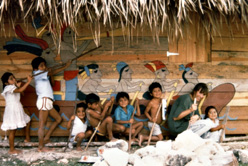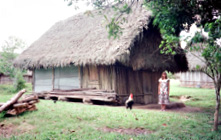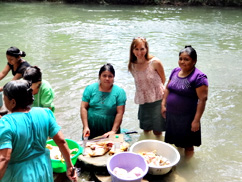Talking with Nancy Heil Knor (Belize), author of WOVEN
Nancy, where and when did you serve in the Peace Corps?
I had the privilege of serving in the village of San Pedro Columbia in Belize, Central America, from 1989–1991. I loved it! The village is inhabited by K’ekchi Mayan families who are mostly subsistence farmers. When I lived there, the population was about 1,000 people; it was one of the larger Mayan villages in the southernmost district of Belize.
What was your Peace Corps project assignment?
Originally, I was sent to the village to teach the villagers how to plant carrots in order to increase their intake of Vitamin A. Vitamin A helps prevent vision loss — something that many of the K’ekchi experience. The project, which was called Relevant Education for Agricultural Production (REAP), was a district-wide initiative, but, unfortunately, we Volunteers found it difficult to implement. Most of us were trained as teachers and had grown up buying our produce at the local grocery store! We had very little agricultural experience while the people we were supposed to be “teaching” were farmers by trade. Thankfully, after hearing of the difficulty we were having implementing REAP, Peace Corps/Belize released us to create our own self-generated projects depending on the needs of our villages. My project became clear several months after I arrived when I noticed the insatiable hunger that the people of San Pedro Columbia had — not for vegetables — but for books. The few picture books I had brought with me were shared by men, women, and children alike until the bindings cracked, and I had a waiting list of village men who wanted to borrow my Peace Corps-issued Newsweek Magazine>

Nancy and helpers outside the newly built Se Le Pan Library (The Toucan Library)
This hunger for reading material helped crystallize my project: I would work alongside the villagers to create the first-ever San Pedro Columbia Library. The San Pedro Library Committee applied for grants and wrote letters to book agencies while the school children in the village participated in a cultural exchange with an elementary school in New Jersey. All the villagers participated in creating a beautiful building, painting Mayan figures on the walls, and running the library. And with over 1,000 books, the Se Le Pan Library — The Toucan Library — was a huge success.
Tell us about where you lived and worked.

My home
I lived in a thatch-roofed house located right next to the beautiful San Pedro Columbia River which also served as my bathtub, dishwasher, and washing machine. Thankfully, I rented my home from a lovely family who became my “family” during my two years in the village. I ate dinner with them every night and learned to pat tortillas, cook over an open fire, smooth the mud floor until it looked like concrete, and speak K’ekchi reasonably well. The village did not have electricity at the time, so we spent our evenings swinging in hammocks, laughing, and talking about the events of the day. My relationship with this special family was by far one of the best parts of my tour.
Where did you work?
I was assigned to help the villages of San Pedro Columbia, Laguna, and Forrest Homes. The villages were 17 miles apart, so I was issued a motorcycle so that I could travel easily between them. In Laguna, I helped the school children record the village history by interviewing the older citizens of the community. The project culminated in a ceremony and the opening of the Laguna Museum — a temporary display of the art and culture of the village. In Forrest Home, I offered teacher training and taught a health and science class, and in my home village of Columbia, I assessed all the school children and taught three classes of remedial readers in addition to working on my primary project, the Se Le Pan Library.
What was your educational background?
I graduated from Vanderbilt University with a double major (B.S.) in Elementary Education and Special Education.
Did your college education help you as a PCV?
Yes! College broadened my perspective about the world and gave me the chance to be independent. I was a Resident Advisor which also gave me leadership experience and plenty of chances to interact with people. This had a huge impact on me since I am a bit shy by nature. I also learned to use my critical thinking skills as I wrestled with complex issues. And, of course, the friends I met at Vanderbilt served as my umbilical cord to the States during my two years abroad (you will meet them through their letters in my book!)
What have you done since the Peace Corps?
My favorite job titles have been Wife and Mother. I married the love of my life and raised (and homeschooled) my two children. I also have had the opportunity to teach for a year in the Philippines alongside my husband and back in the States in public, private, and Montessori settings.
What are you doing now?
I live in Maryland with my husband, daughter Grace, and two dogs — a bloodhound named Macy and a black Lab named Noah. My son, Josiah, is in his second year of studying film at Gettysburg College. I am currently working as the Neurodivergent Specialist at a private school called Fusion Academy where all the classes are one-on-one. There is nothing I like better than helping kids with learning differences uncover their strengths and unleash their potential.
How would you describe your book in one sentence?
Through journal entries, letters, and spiritual reflections, Woven invites the reader to experience the adventure, ups and downs, and personal growth of life as a Peace Corps Volunteer in the lovely K’ekchi Mayan village of San Pedro Columbia.
What prompted you to write the book?
The idea first came to me during my Peace Corps tour in Belize. As mail bags filled with books poured into San Pedro Columbia for the new library, I couldn’t help notice that most of the books we received centered around themes that were irrelevant to the library’s K’ekchi readers. Books about babysitters, skyscrapers, and American “issues,” while greatly appreciated, were just not relatable for the people of San Pedro Columbia. I remember wishing that my K’ekchi friends had literature about themselves to read. I wished they had a book where Mayan characters were the protagonists and where their village was the setting — and this wish never quite left me. I knew I would not be able to write a book from the Mayan perspective — that is a job for a Mayan writer — but I knew I could write one from my point of view as a Peace Corps Volunteer. And so, I wrote Woven — a book filled with letters, journal entries, and spiritual reflections (from a Judeo-Christian perspective) from my two years in Belize. The book would not be about babysitters or skyscrapers. It would take place in the lovely village of San Pedro Columbia and it would be dedicated to my K’ekchi friends — the true heroes of my story.
How long did it take for you to write the book?

Washing chicken at the San Pedro Columbia River with Tomas (left) and Evarista (right)
23 years! Thanks to a persistent little K’ekchi pen pal, Telesforo Chiac, who faithfully wrote me letters when I returned to the United States after the Peace Corps, I stayed in touch with my Mayan friends and host family. And, finally, twenty-two years after I left, I had the privilege of going back to the village to visit. Telesforo had grown into an insightful and reflective young man who had a heart for the Mayan people and a desire to honor and promote his beautiful culture. It was Telesforo’s enthusiasm that rekindled my interest in writing a book.
Tell me about your writing process.
Although it took 23 years to begin the writing process, once I got started, I couldn’t stop! I had the opportunity to stay at home for one year while my kids were in high school. After I dropped the kids off at school, I would grab a cup of Earl Grey or Jasmine Green tea, pray, and then hunker down at my computer to write until they got home. My writing required a lot of research and reflection, too. Even before the computer work, I had to dig through all my letters and journal entries and file them in chronological order. Since I hadn’t read the letters in years, I would often tear up as I read kind words from my family and friends. I was also in awe of how my adventure was so beautifully woven together — this was something I hadn’t noticed prior to reading and compiling all the writings from the time. I loved “hunting” for the golden thread that wound itself through my story and eventually brought me to where I am today.
While writing your book did you take any inspiration from other RPCV writers?
Robyn Harrison, a fellow PCV from Belize, was my biggest support and inspiration for the project. I contacted her initially because I wanted to include a letter from her in my book; I did not know that my inquiry would bring me an editor, formatter, and true friend! We started off sharing our writings back and forth over email and enjoying each other’s words and insights in a shared blog. (Robyn lives in New Mexico, and I am a Marylander). Although we come from different backgrounds and hold different beliefs, Robyn encouraged me to share my Peace Corps story from my eyes. I learned so much from her wisdom, humor, sensitivity, candor, and kindness. One time, when the words weren’t flowing for me, I told Robyn I was so discouraged that I wanted to get “drunk” on chocolate chip cookies. A few days later, I found a UPS box of freshly baked chocolate chip cookies on my front door step.
During the process did you belong to a writer’s group?
Because I was using some many letters from family and friends, my writer’s group became the people who were contributing to my story. Of course, I needed to get permission from all of them, so I shared the story with about 15 people and got feedback from them. (I also asked two people who didn’t know me to give me their more objective opinion.) The vulnerability of sharing my work felt a bit like I was standing on a stage naked (
What are you doing to promote your book?
I recently started a Kickstarter Campaign, and thanks to many generous contributors, I met my goal! My dream is to take one hundred copies of Woven to the village of San Pedro Columbia in December of 2019. I want the villagers to know that their story is a story worth telling. I want to give them relevant literature about themselves. The campaign will also give me a chance to share my story — and the story of my Mayan friends with people all over the world.
•

The Story of the Two Nancys
Little Nancy’s father, Oliverio Chiac, was my most frequent visitor during my two-year tour. He was seven at the time, and we would swing in my hammock every day and read books together. Oliverio would help me gather wood, carry my dishes to the river, sweep my mud floor, and take care of my cat, Weezy. We also called each other “Sweetie” because little Oliverio was not familiar with the word and thought that the term was interchangeable between adults and children. I cherished my special friendship with him then — and I cherish my friendship with him and his wife, Philadelphia, and now their four children – Stephanie, Alex, Nancy, and Hiram (and their dog, Wizard 
•
This is a beautiful story and a great interview. Thank you.
And that is what the Peace Corps experience is all about.
I love this interview not only because it asks the questions I might have asked the author but because it is so gentle.
Yes, a lovely commentary on PC service, with it’s typical twists and turns. It sounds like the PC Admin was up to it, too. John Turnbull Lower Canoncito, New Mexico.
That sounded just like NANCY, beautiful and kind. I have been blessed to have here in my life
I remember Nancy , she always had a book for me to read….my class also participated in the exchange with the kids from New Jersey..I am wondering if Nancy is still around
Pasiano!!
I just saw your comment. It made me so happy to “hear” your voice after all these years! Are you still in Columbia? What are you up to these days?!
Pasiano!!
I just saw your comment. It made me so happy to “hear” your voice after all these years! Are you still in Columbia? What are you up to these days?!
Hi Nancy,
This is Tracey Heusinkveld McGuire I was a volunteer in Aguacate’. I recently discovered your book and bought 2 copies. I’m planning on sending one to Chris Drake as well.
I enjoyed reading your interview. I am over the moon excited to read your book!!!!
Tracey
Hi Miss Nancy. I hope you get to read this. I was a preteen when you were in San Pedro Columbia. We used to go visit you and you would make nice pancakes and shared it with us. I remembered those pancakes and I looked forward to visiting you at your house by Mr Chiac. The library was my favorite place to go to. There was always a book to read. I love reading. I sincerely hope you are ok and it has been many years. Please respond if you get a chance to read this. Polfina
Hello, Polfina!!
I am so glad to hear from you. Thank you for writing to me. I’m so glad you love to read books. me, too! The new library is lovely. Do you still go there?? Where are you living right now?? I hope you are well. I hope I get to see you again and eat pancakes together! Chacuil acuib! Nancy